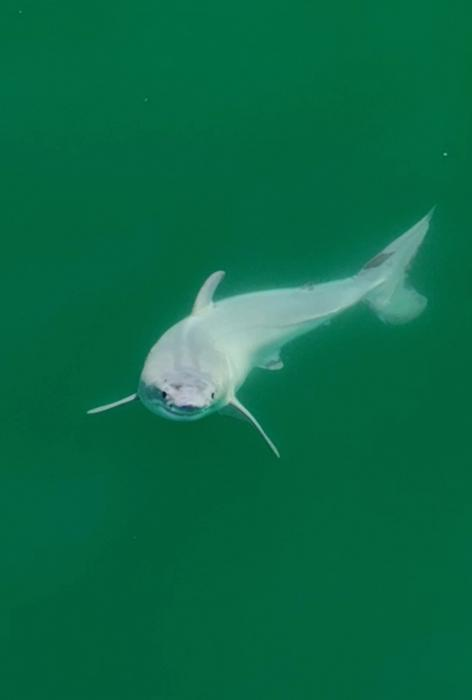It might not be as cute as most baby animals, but the suspected first-ever images capturing a newborn great white shark could be highly scientifically significant.
Great white sharks (Carcharodon carcharias) are the largest surviving fish that prey on anything larger than krill, and the inspiration for films such as Jaws and Sharknado. Scientists refer to them merely as white sharks, animal hierarchies being out of fashion, but they’ll always be great to us. Technically even the white part is debatable, since their top half is gray, following a similar camouflage plan to penguins’ approach of looking dark when seen from above, and white against the sky.
Despite their major role in the ecosystem (and our psyche) little is known about great whites’ reproduction and the lives of their young. While using a drone to film sharks (the safest, as well as the fastest, way to find them) off Carpinteria, California, filmmaker Carlos Guana and of California Riverside PhD candidate Phillip Sternes spotted a young great white. At an estimated 1.5 meters (5 feet) long, the shark was about the expected length for a newborn. This one lived up to its name, being truly white.
Subsequently, however, they saw that this was no albino. “We enlarged the images, put them in slow motion, and realized the white layer was being shed from the body as it was swimming,” Sternes said in a statement.
The pair provide two interpretations of what they have seen: This is a newly born white shark with intrauterine substances sticking to its body or a slightly older shark has an unknown skin disorder “resulting in shedding, discharge, or possibly a microbial growth over the dermal layer.”
The first suggestion in particular would support a long-standing claim that large sharks use the area off Santa Barbara, California to north Baja California in Mexico to give birth. This idea was proposed based on multiple reports of young white sharks in these waters. Nevertheless, most of these were too big to be newborns, leaving open the possibility births occur elsewhere before the young congregate in this region.
Further evidence for the first interpretation is that the drones captured images of large sharks in the area, which may have been about to give birth, both that day and the day before.

A closer version of the baby shark in question, looking cute but deadly.
Image Credit: Carlos Gauna/The Malibu Artist
“Where white sharks give birth is one of the holy grails of shark science,” said Gauna, who is responsible for the videos you may have seen of sharks swimming uncomfortably close to heedless swimmers.
“No one has ever been able to pinpoint where they are born, nor has anyone seen a newborn baby shark alive. There have been dead white sharks found inside deceased pregnant mothers. But nothing like this.”
“This may well be the first evidence we have of a pup in the wild, making this a definitive birthing location,” Sternes added. If so, it could settle a long-standing debate as to whether great whites give birth far out to sea, or in more protected waters close to shore. This one was sighted only about 300 meters (1000 feet) from a beach.
The impossibility of studying captive great whites, particularly pregnant ones, means we don’t know much about their gestation. However, lamniform sharks, the order to which great whites belong, have been observed practicing the unique behavior known as oophagy, where embryos feed on eggs while inside their mother’s uterus.
It may not be quite the ruthless predatory behavior for which the adults are known, but it’s probably good practice, as well as maximizing the size of the embryo prior to birth. Some, such as grey and tawny nurse sharks, take it further, with the first embryo to develop eating other embryos as well as eggs.
Pregnant great whites produce a yellowish fluid called “uterine milk”, possibly to prevent the pups from consuming each other entirely. Guana and Sternes think the material coming off this one might be the milk, or something related, that got stuck on its skin rather than being consumed.
Great whites may rank one step above mosquitoes on a list of many people’s priorities to save, but unlike most insect vampires they’re recognized as endangered and essential for healthy oceans. “Further research is needed to confirm these waters are indeed a great white breeding ground,” Sternes said. “But if it does, we would want lawmakers to step in and protect these waters to help white sharks keep thriving.”
The study is published in Environmental Biology of Fishes.
Source Link: World’s First Sighting Of A Newborn Baby Great White Shark Off California